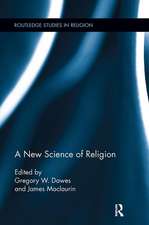Future Remains: A Cabinet of Curiosities for the Anthropocene: Emersion: Emergent Village resources for communities of faith
Editat de Gregg Mitman, Marco Armiero, Robert Emmetten Limba Engleză Paperback – 20 apr 2018
What can a pesticide pump, a jar full of sand, or an old calico print tell us about the Anthropocene—the age of humans? Just as paleontologists look to fossil remains to infer past conditions of life on earth, so might past and present-day objects offer clues to intertwined human and natural histories that shape our planetary futures. In this era of aggressive hydrocarbon extraction, extreme weather, and severe economic disparity, how might certain objects make visible the uneven interplay of economic, material, and social forces that shape relationships among human and nonhuman beings?
Future Remains is a thoughtful and creative meditation on these questions. The fifteen objects gathered in this book resemble more the tarots of a fortuneteller than the archaeological finds of an expedition—they speak of planetary futures. Marco Armiero, Robert S. Emmett, and Gregg Mitman have assembled a cabinet of curiosities for the Anthropocene, bringing together a mix of lively essays, creatively chosen objects, and stunning photographs by acclaimed photographer Tim Flach. The result is a book that interrogates the origins, implications, and potential dangers of the Anthropocene and makes us wonder anew about what exactly human history is made of.
Future Remains is a thoughtful and creative meditation on these questions. The fifteen objects gathered in this book resemble more the tarots of a fortuneteller than the archaeological finds of an expedition—they speak of planetary futures. Marco Armiero, Robert S. Emmett, and Gregg Mitman have assembled a cabinet of curiosities for the Anthropocene, bringing together a mix of lively essays, creatively chosen objects, and stunning photographs by acclaimed photographer Tim Flach. The result is a book that interrogates the origins, implications, and potential dangers of the Anthropocene and makes us wonder anew about what exactly human history is made of.
Din seria Emersion: Emergent Village resources for communities of faith
-
 Preț: 183.89 lei
Preț: 183.89 lei -
 Preț: 229.92 lei
Preț: 229.92 lei -
 Preț: 94.22 lei
Preț: 94.22 lei -
 Preț: 182.98 lei
Preț: 182.98 lei -
 Preț: 140.57 lei
Preț: 140.57 lei -
 Preț: 104.20 lei
Preț: 104.20 lei - 9%
 Preț: 351.96 lei
Preț: 351.96 lei - 17%
 Preț: 422.51 lei
Preț: 422.51 lei -
 Preț: 208.31 lei
Preț: 208.31 lei - 18%
 Preț: 348.05 lei
Preț: 348.05 lei -
 Preț: 273.93 lei
Preț: 273.93 lei -
 Preț: 176.35 lei
Preț: 176.35 lei - 9%
 Preț: 352.23 lei
Preț: 352.23 lei -
 Preț: 115.82 lei
Preț: 115.82 lei -
 Preț: 164.43 lei
Preț: 164.43 lei - 12%
 Preț: 290.09 lei
Preț: 290.09 lei -
 Preț: 307.53 lei
Preț: 307.53 lei -
 Preț: 147.26 lei
Preț: 147.26 lei -
 Preț: 113.18 lei
Preț: 113.18 lei - 8%
 Preț: 359.72 lei
Preț: 359.72 lei -
 Preț: 209.69 lei
Preț: 209.69 lei -
 Preț: 123.69 lei
Preț: 123.69 lei - 14%
 Preț: 158.92 lei
Preț: 158.92 lei -
 Preț: 296.72 lei
Preț: 296.72 lei -
 Preț: 101.43 lei
Preț: 101.43 lei -
 Preț: 146.50 lei
Preț: 146.50 lei - 8%
 Preț: 564.99 lei
Preț: 564.99 lei -
 Preț: 156.84 lei
Preț: 156.84 lei -
 Preț: 157.35 lei
Preț: 157.35 lei -
 Preț: 185.37 lei
Preț: 185.37 lei -
 Preț: 176.35 lei
Preț: 176.35 lei -
 Preț: 179.93 lei
Preț: 179.93 lei -
 Preț: 144.99 lei
Preț: 144.99 lei - 12%
 Preț: 251.56 lei
Preț: 251.56 lei -
 Preț: 310.21 lei
Preț: 310.21 lei -
 Preț: 537.64 lei
Preț: 537.64 lei -
 Preț: 138.33 lei
Preț: 138.33 lei -
 Preț: 161.12 lei
Preț: 161.12 lei -
 Preț: 131.27 lei
Preț: 131.27 lei - 8%
 Preț: 311.20 lei
Preț: 311.20 lei - 9%
 Preț: 352.72 lei
Preț: 352.72 lei - 18%
 Preț: 2257.84 lei
Preț: 2257.84 lei - 8%
 Preț: 345.80 lei
Preț: 345.80 lei -
 Preț: 123.07 lei
Preț: 123.07 lei - 8%
 Preț: 563.24 lei
Preț: 563.24 lei -
 Preț: 273.97 lei
Preț: 273.97 lei - 6%
 Preț: 324.45 lei
Preț: 324.45 lei -
 Preț: 141.84 lei
Preț: 141.84 lei -
 Preț: 92.35 lei
Preț: 92.35 lei -
 Preț: 163.52 lei
Preț: 163.52 lei
Preț: 200.45 lei
Nou
Puncte Express: 301
Preț estimativ în valută:
38.37€ • 39.95$ • 31.59£
38.37€ • 39.95$ • 31.59£
Carte disponibilă
Livrare economică 11-25 ianuarie 25
Livrare express 28 decembrie 24 - 03 ianuarie 25 pentru 26.35 lei
Preluare comenzi: 021 569.72.76
Specificații
ISBN-13: 9780226508795
ISBN-10: 022650879X
Pagini: 224
Ilustrații: 16 color plates, 9 halftones
Dimensiuni: 178 x 229 x 20 mm
Greutate: 0.43 kg
Ediția:1
Editura: University of Chicago Press
Colecția University of Chicago Press
Seria Emersion: Emergent Village resources for communities of faith
ISBN-10: 022650879X
Pagini: 224
Ilustrații: 16 color plates, 9 halftones
Dimensiuni: 178 x 229 x 20 mm
Greutate: 0.43 kg
Ediția:1
Editura: University of Chicago Press
Colecția University of Chicago Press
Seria Emersion: Emergent Village resources for communities of faith
Notă biografică
Gregg Mitman is the Vilas Research and William Coleman Professor of History of Science, Medical History, and Environmental Studies at the University of Wisconsin-Madison. He is the author of Breathing Space: How Allergies Shape Our Lives and Landscapes and coeditor of Documenting the World: Film, Photography, and the Scientific Record, the latter also published by the University of Chicago Press. Marco Armiero is associate professor of environmental history and the director of the Environmental Humanities Lab at the Royal Institute of Technology, Stockholm. He is the author of A Rugged Nation: Mountains and the Making of Italy and coeditor of Nature and History in Modern Italy and A History of Environmentalism: Local Struggles, Global Histories. Robert S. Emmett is visiting assistant professor of environmental studies at Roanoke College, Virginia. He is the author of Cultivating Environmental Justice: A Literary History of US Garden Writing.
Cuprins
Acknowledgments
Preface
Gregg Mitman, Marco Armiero, and Robert S. Emmett
The Anthropocene: The Promise and Pitfalls of an Epochal Idea
Rob Nixon
Hubris
Anthropocene in a Jar
Tomas Matza and Nicole Heller
Concretes Speak
Rachel Harkness, Cristián Simonetti, and Judith Winter
The Age of (a) Man
Joseph Masco
The Manual Pesticide Spray Pump
Michelle Mart and Cameron Muir
Hubris or Humility: Genealogies of the Anthropocene
Gregg Mitman
Living and Dying
Huia Echoes
Julianne Lutz Warren
Snarge
Gary Kroll
Marine Animal Satellite Tags
Nils Hanwahr
Artificial Coral Reef
Josh Wodak
Freezing Life in the Anthropocene
Elizabeth Hennessy
Racism and the Anthropocene
Laura Pulido
Sabotaging the Anthropocene; or, In the Praise of Mutiny
Marco Armiero
Laboring
On Possibility; or, The Monkey Wrench
Daegan Miller
The German Calico Quilt
Bethany Wiggin
Anthropocene Aesthetics
Robert S. Emmett
Making
The Mirror—Testing the Counter-Anthropocene
Sverker Sörlin
Objects from Anna Schwartz’s Cabinet of Curiosities
Judit Hersko
Technofossil
Jared Farmer
Davies Creek Road
Trisha Carroll and Mandy Martin
Anthropocene Cabinets of Curiosity: Objects of Strange Change
Libby Robin
Contributors
Preface
Gregg Mitman, Marco Armiero, and Robert S. Emmett
The Anthropocene: The Promise and Pitfalls of an Epochal Idea
Rob Nixon
Hubris
Anthropocene in a Jar
Tomas Matza and Nicole Heller
Concretes Speak
Rachel Harkness, Cristián Simonetti, and Judith Winter
The Age of (a) Man
Joseph Masco
The Manual Pesticide Spray Pump
Michelle Mart and Cameron Muir
Hubris or Humility: Genealogies of the Anthropocene
Gregg Mitman
Living and Dying
Huia Echoes
Julianne Lutz Warren
Snarge
Gary Kroll
Marine Animal Satellite Tags
Nils Hanwahr
Artificial Coral Reef
Josh Wodak
Freezing Life in the Anthropocene
Elizabeth Hennessy
Racism and the Anthropocene
Laura Pulido
Sabotaging the Anthropocene; or, In the Praise of Mutiny
Marco Armiero
Laboring
On Possibility; or, The Monkey Wrench
Daegan Miller
The German Calico Quilt
Bethany Wiggin
Anthropocene Aesthetics
Robert S. Emmett
Making
The Mirror—Testing the Counter-Anthropocene
Sverker Sörlin
Objects from Anna Schwartz’s Cabinet of Curiosities
Judit Hersko
Technofossil
Jared Farmer
Davies Creek Road
Trisha Carroll and Mandy Martin
Anthropocene Cabinets of Curiosity: Objects of Strange Change
Libby Robin
Contributors
Recenzii
“Evocative. . .A brief review cannot do justice to all that these haunting Anthropocene objects and their accompanying essays say about the future. The essays offer strikingly original and often lyrical meditations
on the ecological and moral tragedies of the Anthropocene as well as the possibilities for creative adaptation and radical hope. The collection’s considerable literary merits are complemented by the aesthetic
beauty of the photographs by Tim Flach. This book compels the reader to ponder the material, intellectual, and moral experiences of the Anthropocene and is richly deserving of a wide readership in the academy and beyond.”
on the ecological and moral tragedies of the Anthropocene as well as the possibilities for creative adaptation and radical hope. The collection’s considerable literary merits are complemented by the aesthetic
beauty of the photographs by Tim Flach. This book compels the reader to ponder the material, intellectual, and moral experiences of the Anthropocene and is richly deserving of a wide readership in the academy and beyond.”
“A significant take on an important yet somewhat nebulous concept, surveying as it does a variety of ways in which people have used or reshaped the planet and its material wealth.”
“In this collection of essays edited by Gregg Mitman, Marco Armiero, and Robert S. Emmett, objects take center stage and are enlivened with clever metaphor and meaning to narrate the tale of the Anthropocene. Each object presented in this volume is intricately interconnected to place, space, and time, and to the larger planetary scale within which scholars are increasingly starting to explore. . . . Each essay is well written, some are in an almost poetic prose, while others present as personal stories or dialogues, but each tells its own material journey into the Anthropocene.”
“Objects, cabinets, remains: here is an assembling of wonders from a damaged planet, brought together in order to cultivate the arts of remembering effectively, so as to care seriously, to care for, to care with. Each essay is a provocation to curiosity in the sense of incitement to feel, know, care, and respond. Writing and images converge to make objects present so as to render remaining futures vital.”
“This book addresses the vexing issues posed by the Anthropocene—the idea that humans have become a bio-physical force of nature—in an excitingly original way by showing how the material objects of our time will one day become uncanny future fossils. Its imaginative sweep feels as futuristic as science fiction, yet each object is located deftly within its historical and contemporary context. The contributors make up a who’s who of modern scholarship. It should become the go-to book for understanding the implications and significance of the most challenging idea and problem of our time.”
“Future Remains explores the ways in which scholarship and art can come together to experiment with the consequences of thinking the oxymoronic power and powerlessness of humans entailed by the implications of an age of humans. It is able to both eulogize and mock the losses and aspirations that the anthropogenic illusion of control has brought about the planet. . . . It should be read as an invitation to start collecting by asking objects for their stories, their specific entanglements with humans and nature and, hence, to contribute object stories to this Wunderkammer in the hope that it is more alive than it might seem at first glance.”











